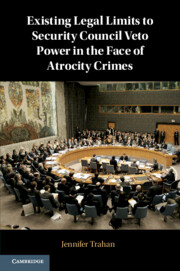Book contents
- Existing Legal Limits to Security Council Veto Power in the Face of Atrocity Crimes
- Existing Legal Limits to Security Council Veto Power in the Face of Atrocity Crimes
- Copyright page
- Contents
- Foreword
- Acknowledgments
- Introduction
- 1 The Origins and History of the Veto and Its Use
- 2 Acting in the Face of Atrocity Crimes
- 3 Initiatives to Voluntarily Restrain Veto Use in the Face of Atrocity Crimes
- 4 Questioning the Legality of Veto Use in the Face of Genocide, Crimes against Humanity, and/or War Crimes
- 5 Case Studies
- Index
1 - The Origins and History of the Veto and Its Use
Published online by Cambridge University Press: 15 August 2020
- Existing Legal Limits to Security Council Veto Power in the Face of Atrocity Crimes
- Existing Legal Limits to Security Council Veto Power in the Face of Atrocity Crimes
- Copyright page
- Contents
- Foreword
- Acknowledgments
- Introduction
- 1 The Origins and History of the Veto and Its Use
- 2 Acting in the Face of Atrocity Crimes
- 3 Initiatives to Voluntarily Restrain Veto Use in the Face of Atrocity Crimes
- 4 Questioning the Legality of Veto Use in the Face of Genocide, Crimes against Humanity, and/or War Crimes
- 5 Case Studies
- Index
Summary
This chapter traces the origins of the veto power of the permanent members of the UN Security Council from the negotiations leading into the San Francisco Conference to the finalization of the UN Charter. It then examines early response to Security Council paralysis – resolutions in the late 1940s by the General Assembly calling for veto restraint as well as the “Uniting for Peace” Resolution in 1950. Even though expectations for the Security Council have probably gone beyond the intention of the drafters of the UN Charter, especially since the end of the Cold War it is clear that when there is sufficient political will, this body has the legal ability to prevent or stop many situations of catastrophic consequences to communities, countries, and regions around the world. Concomitantly, when the Council does not take on such a role, there is widespread disenchantment with its performance. The lack of responsiveness to the commission of mass atrocity crimes (genocide, crimes against humanity, and/or war crimes), which have occurred virtually unimpeded in places such as Rwanda, Darfur, Syria, Sri Lanka, Myanmar, and Yemen has come at a staggering toll in terms of lives lost. Much of the time, inaction by the Council can be specifically traced to use of the veto, or the threat of the veto, by one or more of the permanent members. This chapter makes the case that it is time to reconsider existing hard law legal obligations and recognize that these in fact impose limitations on the use of the veto in the face of atrocity crimes.
Keywords
- Type
- Chapter
- Information
- Publisher: Cambridge University PressPrint publication year: 2020

